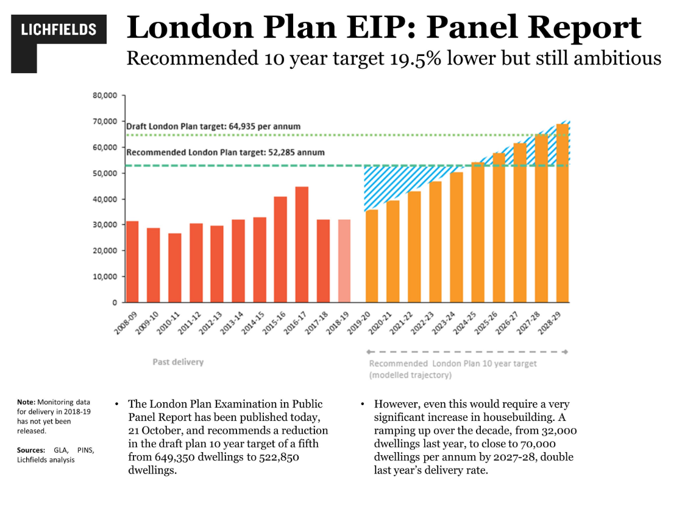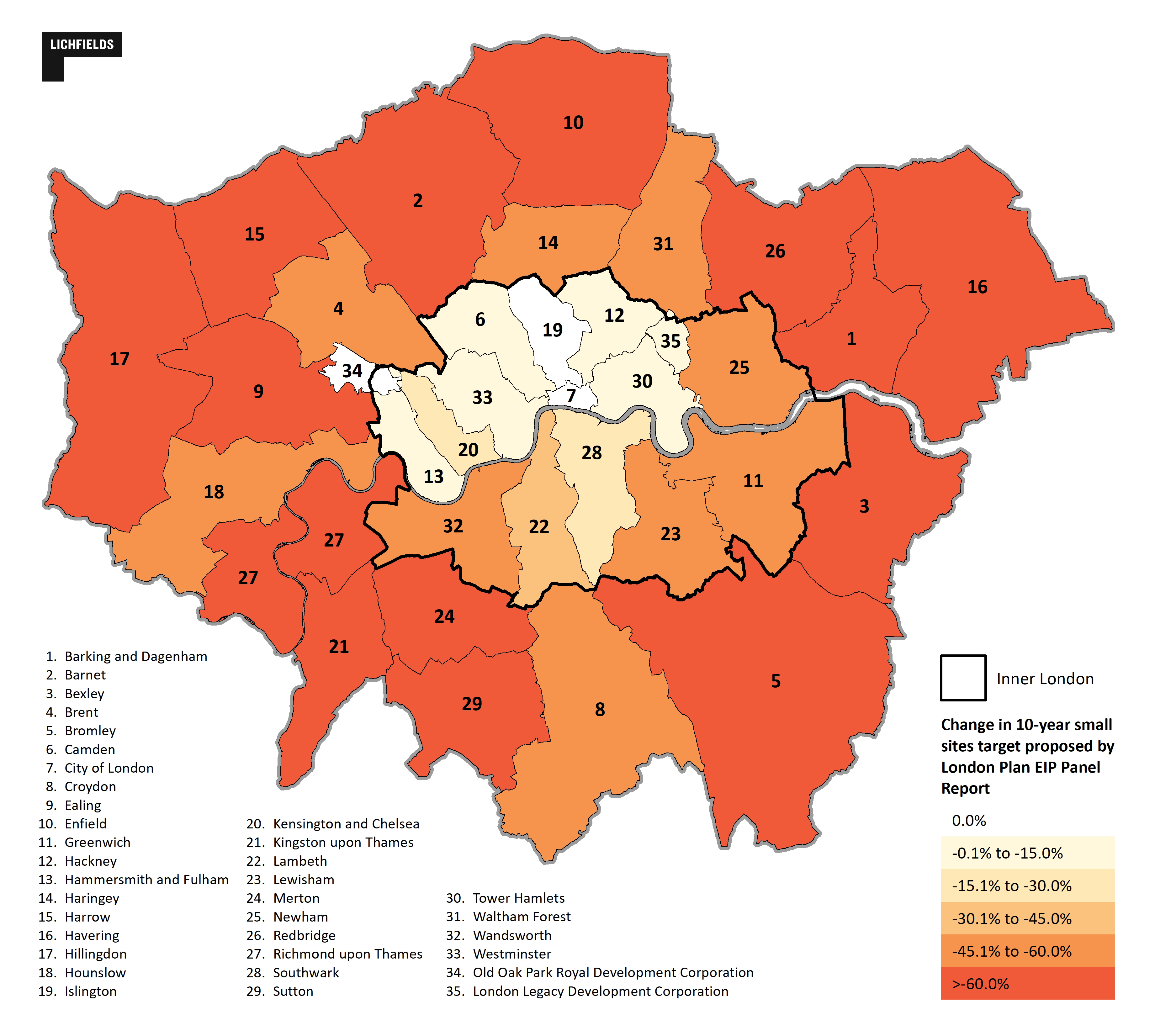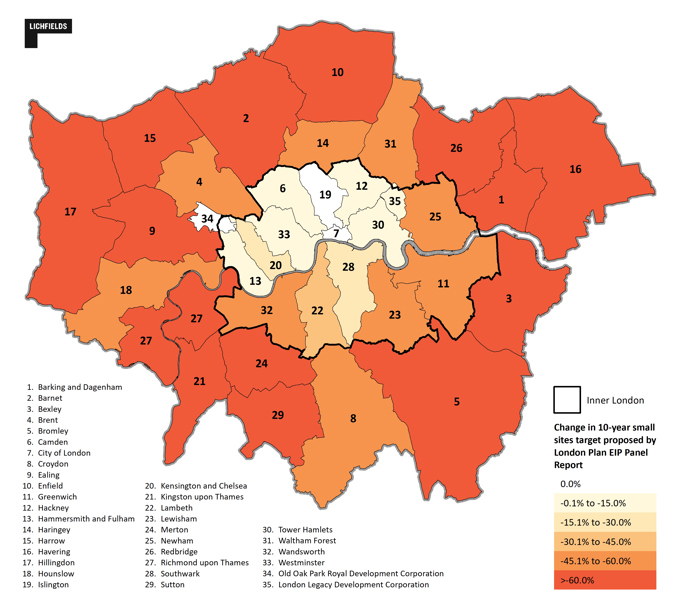Draft New London Plan Panel Report issued
The Panel of Inspectors examining the Mayor’s draft London Plan issued their report to him on 8 October and it was made public on 21 October.
The Panel has prepared a 125 page report with a non-technical summary and annexed table of recommendations. The draft New London Plan has been found
sound
[1] and in accordance with the relevant legislation and national policy subject to the Panel’s recommendations.
The Mayor must now submit to the Secretary of State (SoS) the version of the draft Plan that he intends to publish, together with (if applicable) a statement of his reasons for not accepting the recommendations of the Panel Report. The SoS will then have up to six weeks to decide whether or not to direct amendments.
The Examination in Public webpage indicates that the Mayor intends to publish the final London Plan in February or March 2020.
The Panel’s recommendations of particular note include:
- Reduced housing targets and small sites targets to be more realistic and increasing the gap between need and supply
- Modifying Green Belt policy in order that it reflects national policy
- More industrial land is required or existing industrial land should be used more intensively; London’s future industrial land needs are probably higher than is assumed in the draft Plan mainly because of growth in demand for storage and warehousing within and close to urban locations.
- Making nomination agreements between universities and student accommodation providers can be a protracted process; consequently the draft Plan’s requirement for such agreements might discourage delivery and should be removed; policy encouragement is sufficient
- Policy DF1, which expects that viability testing is normally only undertaken on a site-specific basis where there are clear circumstances creating barriers to delivery, should be modified to ensure that the expectations relating to site specific viability assessments only apply where relevant policies in local plans are up to date.
- The Mayor should commit to instigating and leading a London-wide accommodation assessment for gypsies and travellers, reflecting the fact that London is a single housing market as well as ensuring a consistent methodology and including those on the move
- Policy T8 and its reasoned justification, which says the Mayor will oppose the expansion of Heathrow Airport unless certain tests are met. should be deleted as it is is fundamentally inconsistent with national policy
The Panel has implied that given the time it would take to make major revisions to the document it made some concessions over how far reaching its recommendations are. These are in terms of the draft Plan’s focus on detailed means of implementation rather than a concise development strategy focused on strategic outcomes, and in respect of a review of the Green Belt or discussions with wider South East local authorities regarding housing land supply being essential to increasing housing delivery. These amendments are considered necessary, but to be taken on board in a future Plan.
Sceptical on small sites targets
In terms of housing supply the Panel has concluded that the 2017 Strategic Housing Market Assessment (SHMA) provides a reliable starting point for the housing needs of London, agreeing that 66,000 additional homes per year is properly calculated, a need of 660,000 homes over 2019-2029. But in terms of meeting that need, the Panel’s findings diverge from the Mayor’s approach which relied heavily on theoretical small site capacity modelling contained within the SHLAA. The draft Plan proposed a 10-year capacity-based target of 649,350 homes with a target for 245,730 on small sites (below 0.25 hectares in size). But the Panel recommends cutting the small sites target to 119,250 and hence overall delivery target to 522,850 (a 19.5% reduction) citing that they are “sceptical about the delivery” from small sites and that the assumed delivery from this source was not “realistically achievable”.
The Panel Report says:
“To accept the targets attributed to many of the boroughs would be setting up the Plan to fail. It is likely that some of them would be unable to demonstrate a 5 year supply of housing sites as the Housing Delivery Test would apply to individual boroughs and so result in adverse impacts. The Plan would also impose undesirable consequences on Londoners as plan-making at local level would struggle to achieve unrealistic expectations”.
The implication of this is an increase in London’s unmet housing need, which under the Panel’s recommendations would crystallise at c.14,000 homes per year. The Panel highlights that “it is a major concern that the targets are so far below the assessed need”, but whilst noting that addressing the issue would likely require considerations of Green Belt review or co-operation with local authorities in the wider south-east indicate it is better to “proceed on the basis of an adopted plan rather than one that is in limbo.”
Flowing from the headline number, the Panel report confirms the principle of the housing requirement operating as 10-year targets, rather than annualised numbers, with a need for the Mayor to take a leading role in setting a trajectory for how that target will be met. Initial analysis by Lichfields indicates any trajectory will need to ramp up delivery over the decade from 32,000 new homes last year, to close to 70,000 homes per year by 2028-29, doubling output over the life of the Plan (see Figure one).
Figure one: London EiP: Panel Report housing targets analysis
 Source: Lichfields Analysis
Source: Lichfields Analysis
Figure two: London EiP: Small sites targets

 Source: Lichfields Analysis
Source: Lichfields Analysis
A series of Lichfields’ Planning Matters blogs on the Panel’s recommendations will be published soon.
[1] The Panel’s Report explains at para 10 “The legal duty relating to soundness set out in section 20(5)(b) of the Planning and Compulsory Purchase Act 2004 (“2004 Act”) does not apply to spatial development strategies such as the London Plan, and the section on planmaking in the 2012 NPPF refers to local plans rather than spatial development strategies. However, in light of the need to ensure consistency with national policy we have applied the soundness tests set out in the NPPF, namely that the Plan should be positively prepared, justified, effective, and consistent with national policy”.
PINS, Report of the Examination in Public of the London Plan 2019 and Recommendations via london.gov.uk
Twitter: Lichfields Think Tank
| |
|
|
|
Quote of the month
|
|
| |
|
|
| |
|
|
| |
|
|
| |
The Government want me to allow fracking in London, back Heathrow Expansion & look into building on the Green Belt – none of which I am willing to do. It's deeply disappointing they don't share London’s priorities of tackling climate change & air pollution.
Sadiq Khan, Mayor of London via Twitter, 22 October 2019 |
|
| |
|
|
Mayor’s Homes for Londoners conference
The Mayor has held a Homes for Londoners conference “making clear to homebuilders his priority is council, social rented, and other genuinely affordable housing, and that development must win the support of Londoners”. According to the Mayor’s press release, the conference focused on the Mayor’s pledge to encourage Good Growth by Design and provided an opportunity for industry to meet with representatives from London boroughs to discuss their property needs.
Mayor of London, Mayor challenges housing industry to earn Londoners’ trust
Secretary of State grants planning permission for Harrow School proposal in MOL following Mayor’s refusal
The SoS has allowed an appeal against the decision of the London Borough of Harrow Council (LBH) (under direction from the Mayor of London) to refuse planning permission for (amongst other things) construction of a new sports building over 3 levels (7269 sqm) and a new science building over 3 levels (3675 sqm). He concluded:
“although the proposed sports building would constitute inappropriate development within MOL and would harm openness through the erosion of the MOL, this harm is outweighed by the VSCs identified above which, when taken individually and as a whole, outweigh the harm identified”.
The SoS also awarded Harrow School full costs arising from unnecessary or wasted expense incurred in the appeal process on the grounds of unreasonable behaviour on the part of the Mayor of London. The costs are to be agreed, the Mayor’s own costs having been approved up to £135,000.
HM Government, Recovered appeal: land at Harrow School, 5 High Street, Harrow (ref: 3208434 - 31 October 2019)PINS Appeal Casework Portal for appeal APP/M5450/W/18/3208434
| |
|
|
|
The Lichfields perspective
|
|
| |
|
|
| |
|
|
| |
|
|
| |
Once again London’s housing requirement is recommended to be a capacity based figure, rather than one based on seeking to meet local housing need (as required in the rest of the country). The shortfall against need is set to increase by some 13,715 p.a. following the Panel’s view that Small Sites can only contribute half the numbers the Mayor identifies. The recommended comprehensive Green Belt review is laudable, but ought to be immediate to help address London’s housing crisis.
Steven Butterworth, Senior Director |
|
| |
|
|
| |
|
|
Disclaimer: This publication has been written in general terms and cannot be relied on to cover specific situations. We recommend that you obtain professional advice before acting or refraining from acting on any of the contents of this publication. Lichfields accepts no duty of care or liability for any loss occasioned to any person acting or refraining from acting as a result of any material in this publication. Lichfields is the trading name of Nathaniel Lichfield & Partners Limited. Registered in England, no.2778116
 Source: Lichfields Analysis
Source: Lichfields Analysis



